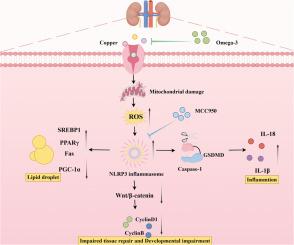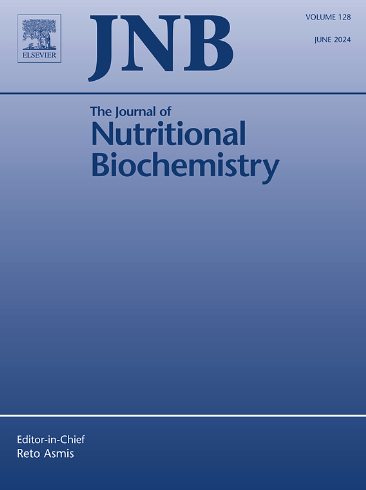Dietary omega-3 alleviates copper-induced nephrotoxicity via suppression of NLRP3-mediated pyroptosis and lipid metabolism disorder in chickens
IF 4.9
2区 医学
Q1 BIOCHEMISTRY & MOLECULAR BIOLOGY
引用次数: 0
Abstract
Excessive use of copper (Cu) in poultry farming induces nephrotoxicity closely related to inflammatory response and lipid metabolism disorder, but the mechanism remains unclear. Omega-3 (Ω-3), a natural polyunsaturated fatty acid with anti-inflammatory and antioxidative stress properties, has been demonstrated to exert protective effects on the kidneys. However, whether Ω-3 can alleviate Cu-induced renal injury and the underlying mechanisms remain unclear. Therefore, we investigated the effects of Cu exposure on chicken kidney tissues and CEK cells in this study. Subsequent dietary supplementation with Ω-3 was administered to evaluate its ameliorative effects on Cu-induced renal injury. Cu exposure significantly disrupted mitochondrial homeostasis. This was evidenced by downregulated mRNA levels of OPA1 and MFN1/2, reduced ATP content, tricarboxylic acid (TCA) cycle dysfunction, mitochondrial membrane depolarization, and excessive ROS accumulation. Electron microscopy confirmed that Cu exposure induced pyroptosis in renal cells, accompanied by activation of the NF-κB-NLRP3-GSDMD pathway, leading to significantly upregulated expression of IL-1β, IL-18, Caspase-1, ASC, and GSDMD. Additionally, Cu exposure disrupted lipid metabolism by upregulating PPARγ, SREBP1, and Fas while downregulating PGC-1α, as evidenced by abnormal lipid droplet accumulation observed under electron microscopy. Furthermore, Cu exposure significantly inhibited the Wnt3a/β-catenin signaling pathway, impairing renal repair functions. Notably, the administration of Ω-3 effectively alleviated these adverse effects. This study reveals that Ω-3 exerts its protective effects against Cu-induced nephrotoxicity by modulating the NF-κB-NLRP3-GSDMD axis, the Wnt/β-catenin signaling pathway, and lipid metabolism for the first time. This provides a dietary strategy to enhance poultry health in intensive farming.

饲粮中Omega-3通过抑制nlrp3介导的鸡焦亡和脂质代谢紊乱来减轻铜诱导的肾毒性。
家禽养殖中过量使用铜(Cu)引起的肾毒性与炎症反应和脂质代谢紊乱密切相关,但其机制尚不清楚。Omega-3 (Ω-3)是一种天然多不饱和脂肪酸,具有抗炎和抗氧化应激特性,已被证明对肾脏有保护作用。然而,Ω-3是否能减轻cu诱导的肾损伤及其机制尚不清楚。因此,我们研究了铜暴露对鸡肾组织和CEK细胞的影响。随后膳食补充Ω-3,以评估其对铜诱导肾损伤的改善作用。铜暴露显著破坏线粒体稳态。这可以通过下调OPA1和MFN1/2 mRNA水平、ATP含量降低、三羧酸(TCA)循环功能障碍、线粒体膜去极化和过度ROS积累来证明。电镜证实,铜暴露诱导肾细胞焦亡,同时NF-κB-NLRP3-GSDMD通路激活,导致IL-1β、IL-18、Caspase-1、ASC和GSDMD表达显著上调。此外,铜暴露通过上调PPARγ、SREBP1和Fas而下调PGC-1α来破坏脂质代谢,这在电镜下观察到异常的脂滴积累。此外,Cu暴露显著抑制Wnt3a/β-catenin信号通路,损害肾脏修复功能。值得注意的是,Ω-3有效地缓解了这些不良反应。本研究首次发现Ω-3通过调节NF-κB-NLRP3-GSDMD轴、Wnt/β-catenin信号通路和脂质代谢发挥对cu诱导肾毒性的保护作用。这为集约化养殖中提高家禽健康提供了一种膳食策略。
本文章由计算机程序翻译,如有差异,请以英文原文为准。
求助全文
约1分钟内获得全文
求助全文
来源期刊

Journal of Nutritional Biochemistry
医学-生化与分子生物学
CiteScore
9.50
自引率
3.60%
发文量
237
审稿时长
68 days
期刊介绍:
Devoted to advancements in nutritional sciences, The Journal of Nutritional Biochemistry presents experimental nutrition research as it relates to: biochemistry, molecular biology, toxicology, or physiology.
Rigorous reviews by an international editorial board of distinguished scientists ensure publication of the most current and key research being conducted in nutrition at the cellular, animal and human level. In addition to its monthly features of critical reviews and research articles, The Journal of Nutritional Biochemistry also periodically publishes emerging issues, experimental methods, and other types of articles.
 求助内容:
求助内容: 应助结果提醒方式:
应助结果提醒方式:


